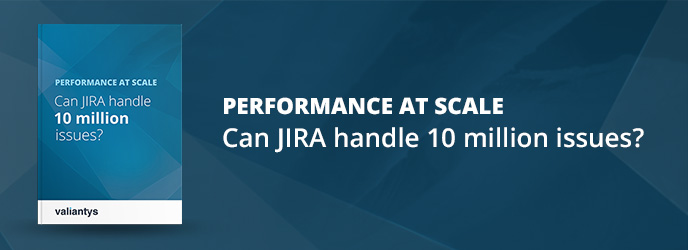Growth in an organisation is usually an exciting time, as new projects means new opportunities for success. However, even during these positive moments there is associated stress. More opportunities also means an increase in instances and issues, and if you’re experiencing growth you may wonder at what point the whole system will come crashing down….
To address this concern head-on, Valiantys’ VP of Corporate Development, Lucas Dussurget, recently published the study ‘Performance at scale: Can JIRA handle 10 million issues?‘. To learn more about this study, I sat down with Lucas over coffee to talk about this initiative.

What prompted Valiantys to commission this study?
The questions from our clients! Numerous companies saw exponential growth in Atlassian tools, making them a critical part of the organisation’s functioning over the years. Today, they question the capacity of the tools to accompany them as their workload increases.
These are the three questions which we get the most frequently:
- When do I need to switch from Server to Data Center? What is the threshold? How should I anticipate this?
- Does Data Center have the capability to manage the volume I am forecasting?
- What is the best architecture to deploy Data Center?
For our study ‘Performance at scale: Can JIRA handle 10 million issues?‘ we chose to concentrate on the second aspect. The idea wasn’t to conduct a complete performance study with global benchmarks from all technologies and from all possible designs. We wanted to find a simple way to answer a question that regularly comes from clients with growing instances, and provide them with some concrete answers about JIRA Software’s scalability.
The goal was to reassure our clients, as Atlassian currently doesn’t provide an official response to these questions.
Why 10 million issues?
JIRA admins generally refer to the number of tickets to evaluate at what stage the performance of their instances starts to deteriorate.
Why 10 million? Its an easy number to say – 1 million seems too little, while 100 million is not realistic. 10 million issues is a good starting point which is relevant to JIRA admins in many companies.
However, it shouldn’t be forgotten that other factors account for the performance of an instance.
The performance of JIRA Software is a mix of three elements: the number of users, the amount of data (number of issues and attachments), and the complexity of the configuration (schemes, add-ons, etc.).
For example, we carried out another study based on a client project which dealt with attachments. Their use cases involved an intensive number of heavy files attached to tickets. This study allowed us to draw interesting conclusions about the behaviour of JIRA Software in such circumstances. It also allowed the company to adapt its design accordingly.
How were the results of this study interpreted?
This study focuses on the performance of JIRA Software.
The environment we used contains an enormous amount of data, yet a relatively simple configuration – no add-ons, for example. The results would certainly be different if we used a more complex configuration with a lot of extensions.
We chose to use Amazon Web Services and we were very satisfied. Again, the results would be different if you use a different hosting service.
The results we obtained shed light on the capabilities of JIRA Software to evolve with large enterprises. It is a reference point, however each environment remains unique.
What is the final performance gap between JIRA Software Server and JIRA Software Data Center?
The results of the study prove this: there is a significant power boost between a standard JIRA Server architecture and JIRA Data Center’s multi-node cluster architecture. JIRA administrators can expect the tool to be up to 3 or 4 times faster!
This also demonstrates the value of using a good load balancer to divide the work.
Want to know more?
Download Performance at scale: Can JIRA handle 10 million issues?




